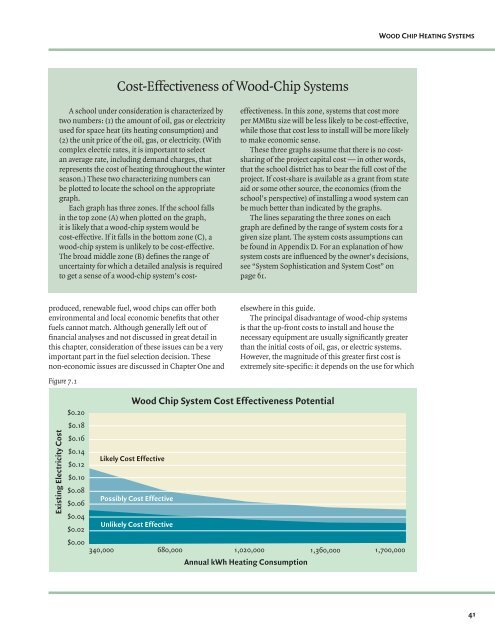Wood-Chip Heating Systems - Biomass Energy Resource Center
Wood-Chip Heating Systems - Biomass Energy Resource Center
Wood-Chip Heating Systems - Biomass Energy Resource Center
Create successful ePaper yourself
Turn your PDF publications into a flip-book with our unique Google optimized e-Paper software.
Cost-Effectiveness of <strong>Wood</strong>-<strong>Chip</strong> <strong>Systems</strong><br />
A school under consideration is characterized by<br />
two numbers: (1) the amount of oil, gas or electricity<br />
used for space heat (its heating consumption) and<br />
(2) the unit price of the oil, gas, or electricity. (With<br />
complex electric rates, it is important to select<br />
an average rate, including demand charges, that<br />
represents the cost of heating throughout the winter<br />
season.) These two characterizing numbers can<br />
be plotted to locate the school on the appropriate<br />
graph.<br />
Each graph has three zones. If the school falls<br />
in the top zone (A) when plotted on the graph,<br />
it is likely that a wood-chip system would be<br />
cost-effective. If it falls in the bottom zone (C), a<br />
wood-chip system is unlikely to be cost-effective.<br />
The broad middle zone (B) defi nes the range of<br />
uncertainty for which a detailed analysis is required<br />
to get a sense of a wood-chip system’s cost-<br />
produced, renewable fuel, wood chips can offer both<br />
environmental and local economic benefi ts that other<br />
fuels cannot match. Although generally left out of<br />
fi nancial analyses and not discussed in great detail in<br />
this chapter, consideration of these issues can be a very<br />
important part in the fuel selection decision. These<br />
non-economic issues are discussed in Chapter One and<br />
Figure 7.1<br />
Existing Electricity Cost<br />
effectiveness. In this zone, systems that cost more<br />
per MMBtu size will be less likely to be cost-effective,<br />
while those that cost less to install will be more likely<br />
to make economic sense.<br />
These three graphs assume that there is no costsharing<br />
of the project capital cost — in other words,<br />
that the school district has to bear the full cost of the<br />
project. If cost-share is available as a grant from state<br />
aid or some other source, the economics (from the<br />
school’s perspective) of installing a wood system can<br />
be much better than indicated by the graphs.<br />
The lines separating the three zones on each<br />
graph are defi ned by the range of system costs for a<br />
given size plant. The system costs assumptions can<br />
be found in Appendix D. For an explanation of how<br />
system costs are infl uenced by the owner’s decisions,<br />
see “System Sophistication and System Cost” on<br />
page 61.<br />
elsewhere in this guide.<br />
The principal disadvantage of wood-chip systems<br />
is that the up-front costs to install and house the<br />
necessary equipment are usually signifi cantly greater<br />
than the initial costs of oil, gas, or electric systems.<br />
However, the magnitude of this greater fi rst cost is<br />
extremely site-specifi c: it depends on the use for which<br />
<strong>Wood</strong> <strong>Chip</strong> System Cost Effectiveness Potential<br />
$0.20<br />
$0.18<br />
$0.16<br />
$0.14<br />
$0.12<br />
$0.10<br />
$0.08<br />
Likely Cost Effective<br />
$0.06<br />
$0.04<br />
Possibly Cost Effective<br />
$0.02<br />
Unlikely Cost Effective<br />
$0.00<br />
340,000 680,000 1,020,000 1,360,000<br />
Annual kWh <strong>Heating</strong> Consumption<br />
WOOD CHIP HEATING SYSTEMS<br />
1,700,000<br />
41





